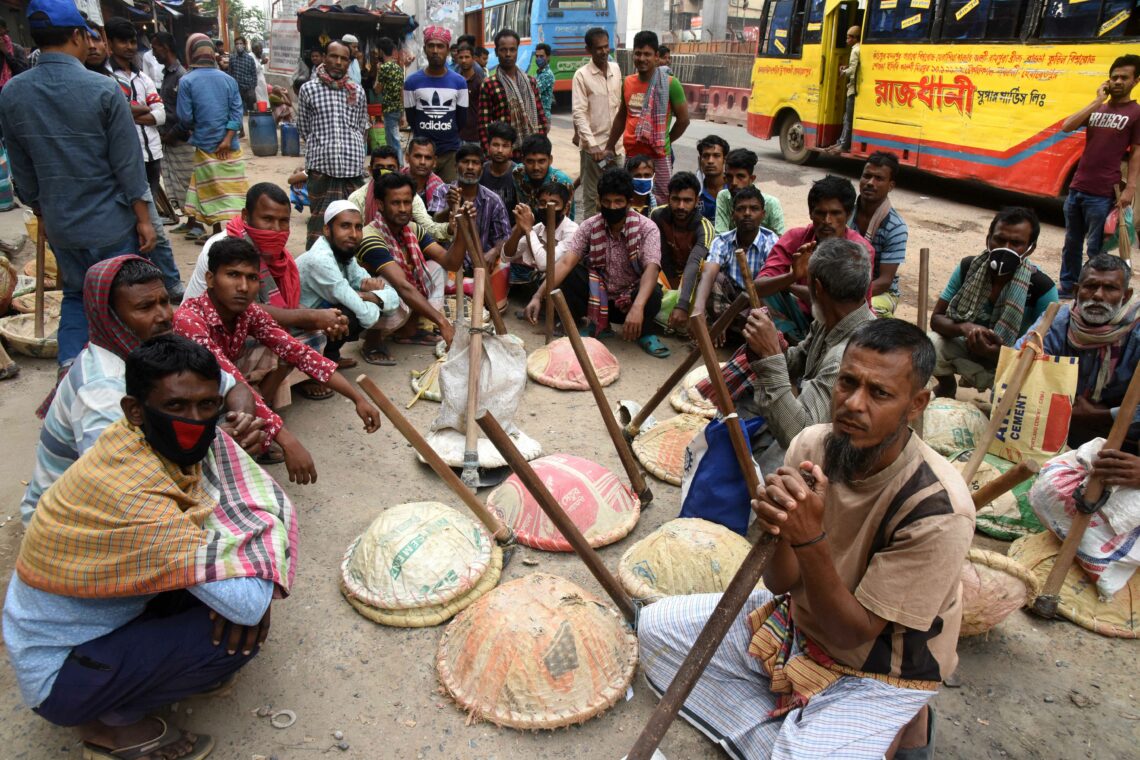Toward a different globalization
In the Western world, middle-class citizens are demanding a return of decent-paying jobs and more environmentally-friendly development. Answering these expectations will require unprecedented levels of supranational coordination.

In a nutshell
- In Western countries, globalization has benefited corporations but not workers
- In the developing world, intense economic growth helped the poor but came at a cost
- A few East Asian countries have developed an alternative model of globalization
Deglobalization is supposedly becoming the consensus definition of a new era in global economics and politics. Trade and investment deals that were the hallmark of the 1990s and the 2000s are now subject to popular backlash. The European Union, which just a decade ago led the trend toward more political consolidation, is now fighting for survival. The spread of COVID-19, enabled by an intricate web of international connections, seems to be tipping the scales in favor of deglobalization.
Globalization in the West
But is the world firmly heading toward deglobalization, or is the trend only a reaction to the Great Recession?
To answer this question, one needs to look into several situations. For years now, North America and Western Europe have embodied the essence of globalization, shortcomings included. They greatly relaxed trade and investment rules, and opened their borders to the rest of the world. They were able to do so because after the collapse of the Soviet Union, there was no existential geopolitical or ideological threat on the horizon. More openness benefited companies, which became more competitive. From an ethical perspective, globalization was thought justified because it brought opportunities to create wealth in all countries, not only those in the developed world.
Most developing countries have seen an increase in standards of living.
However, while globalization certainly profited corporations, it had an impact on the developed world’s middle class, especially the lower-middle class. Industries packed up and moved to Mexico, East Asia or anywhere else where production costs were lower. Already back in 2001, when I drove through the ghost towns of the once-thriving industrial areas of Pennsylvania and upstate New York, the effects were there for all to see.
One can argue about the causes of this phenomenon. Some believe it was the North American Free Trade Agreement and China’s accession to the World Trade Organization (WTO), while others believe it was the shift in skills required to thrive in the modern economy. What is inarguable is the outcome of greater globalization – impoverished communities in the industrial heartlands of the highly-developed Western economies. One of the reasons why the middle class there did not benefit as much as corporations is that professionals and salaried employees cannot move around as easily as companies. If they do move, they also have to compete with cheaper labor in developing countries. With greater mobility for capital and industry, there is a race to the bottom (even within countries) when it comes to the salaries and incomes of the middle class.
Developing countries
For developing countries, meanwhile, globalization has been much more beneficial. In China alone, over 850 million people were lifted out of poverty. Most developing countries around the world – with the exception of those ravaged by wars or natural disasters, or those with severe governance issues – have seen an increase in standards of living. For example, the textile industry in Bangladesh, which makes up almost 85 percent of the country’s exports, illustrates how development can benefit from open markets.
At the same time, globalization has caused severe social dislocations in developing economies. Agriculture was affected by an inflow of cheap products from large and much more efficient Western farms. Uncontrollable urbanization created megalopolises lacking in everything from clean water and sanitation to roads and schools. Lost identities and vanishing traditions caused a vacuum of trust in governance.
In developing countries the higher classes enjoy the same levels of prosperity as their peers in the West. But the lower-income groups, despite an overall increase in income and consumption, have not seen their living standards rise up to match the glamorous lifestyle shown on television and social media. This tension creates a volatile mix, fueling religious fundamentalism, nationalism and intolerance against anything different.
Thus for this second set of countries, the economic benefits of globalization are undeniable, but social dislocations are highly problematic. The countries of Eastern Europe may also fall under this category, since they face many similar consequences: depopulation because of migration to more developed economies, industries at lower and less profitable points of the value chain, and cultural battles to maintain traditions that become political fault lines.

Outliers
A few countries seem to have a different set of issues entirely. Japan is often deemed overly averse to outside influence. And despite efforts to open up, Japanese people still, for instance, buy mostly local cars and electronics. Immigration into the country remains limited. These behaviors might be the outer expression of a deeper phenomenon.
Japan managed to maintain growth, though at more sluggish rates than in the rest of the industrial world, while keeping local communities more or less intact. Visitors cannot fail to notice the incredible attention that is paid to maintaining traditional crafts and skills. Every city or region has its unique cuisine, fashion and pottery, many of which are subsidized by the state. It is safe to say that no other country comes close to Japan in this respect. Small family farms and agricultural businesses, some no larger than the backyard field of an elderly couple, also receive support, thus preserving middle-class livelihood.
Japan’s salaries did not increase significantly over the last three decades, but somehow the Japanese do not feel cheated and left out like the North American and European working classes do.
On the migration issue, Japan has not witnessed the same divisive debates as most developed countries. While Chancellor Merkel was taking in hundreds of thousands of Syrian refugees back in 2015, Tokyo was considering letting in a few dozen. As a result, Japan is probably the only highly-industrialized country in the world where manual labor is mostly not performed by migrant labor.
Japan managed to maintain growth while keeping local communities intact.
Japanese public schools and hospitals have maintained high standards, creating an additional cushion for the middle class to feel safe and secure. Good education and access to health services enable some to climb the social ladder and provide a safety net for the rest. The certainty that anyone can find a paid job solidifies Japan’s middle class – which, while not as rich as it was three decades ago, remains very stable.
Obviously, Japan is facing issues of its own. Slow economic growth and the aging population are creating immense strains on society. However, these problems differ from those caused by rapid globalization. They could foreshadow the challenges that await countries who look likely to opt for less globalization. But while Japan certainly faces worrying trends, its living standards remain extremely high compared to the rest of the world.
This is not to say that Japan is not a globalized country, which it obviously is. Its investments and technologies fueled the rapid growth of tiger economies in Southeast Asia and China. The country’s economy is export-driven. The Japanese travel extensively and were trailblazers for the rest of East Asia in this respect. However, Japan remains much more closed when it comes to small and medium entreprises and immigration.
Some other East Asian and European economies like South Korea, Taiwan, Norway and Switzerland, among others, could be put into this basket, notwithstanding a few reservations. China, which benefited immensely from its accession to the WTO, is edging closer to this group.
Globalization ‘light’
Japan’s example shows that globalization “light” offers an alternative path with less economic growth but more traditional and stable social structures. As barriers to international trade and finance emerge, companies, especially small and medium-sized ones, might be tempted to focus on local markets.
The wave of Chinese exports into industrialized countries was mostly engineered by corporations located in those same importing nations. They poured money, skills and technology into China to sell those products back home. But now the situation has changed.
The gigantic markets offered by India, China and other developing countries are now at least as important as those in the West. There, national companies who face barriers of entry in Western industrialized nations will be able to sell to locals. As a result, global companies could grow smaller and probably less adventurous and innovative.
The Japanese model, wherein products are exported but access to local markets and labor movement is restricted, could be the future of Western countries. It doesn’t mean the end of globalization, just that another form is emerging with more emphasis on trade and investment than labor.
However, it is unclear how globalization “light” would look in developing countries. Some labor-intensive industries could move from China to other countries, something that is already happening. Still, for many developing nations, it could mean that the two past decades of rapid growth were an anomaly rather than the norm. Double-digit growth, or even growth on the higher end of single digits, will seem like a long-forgotten dream.
Another form of globalization is emerging.
However, if deglobalization goes deeper and slows down worldwide growth significantly, the millions of people who migrated to cities because of changes in the agricultural sector will face a much bleaker future. In that case, the developing world should brace itself for a much more volatile political and security situation. Scenes of social breakdown are already emerging in poor areas during the COVID-19 lockdown, offering glimpses of a deglobalized world.
The situation could also lead to ideological deglobalization, turning the clock back on the democratization wave that took hold in developing nations since the 1980s. Poverty and slow growth feed tyrants, while high growth does not always lead to democratization. If industrialized nations limit access to their markets, China, India and, to some extent, Russia could be the only commercial and political alternative left for their immediate neighbors.
“Full” globalization mainly took place in the industrial economies of North America and Western Europe. For them, deglobalization “light” could mean leaning toward the Japanese model. This could bring some companies back. But without extensive policies that support local small and medium-sized businesses and regional development policies that invest in infrastructure, like those of Japan, it is doubtful that affected communities in industrial heartlands will see a significant change.








